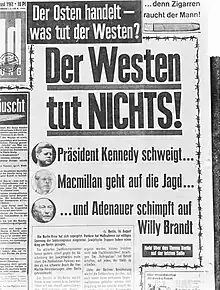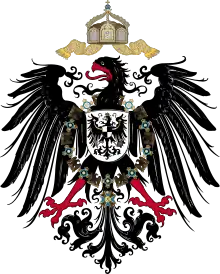Bild
Bild (or Bild-Zeitung, lit. 'Picture'; [bɪlt]) is a German tabloid newspaper published by Axel Springer SE. The paper is published from Monday to Saturday; on Sundays, its sister paper Bild am Sonntag ("Bild on Sunday") is published instead, which has a different style and its own editors. Bild is tabloid in style but broadsheet in size. It is the best-selling European newspaper and has the sixteenth-largest circulation worldwide.[4] Bild has been described as "notorious for its mix of gossip, inflammatory language, and sensationalism" and as having a huge influence on German politicians.[5] Its nearest English-language stylistic and journalistic equivalent is often considered to be the British national newspaper The Sun, the second-highest-selling European tabloid newspaper.[6][7][8]
 Front page, 17 August 1961 | |
| Type | Daily tabloid (except Sundays and public holidays) |
|---|---|
| Format | Broadsheet ("nordisch" size: 376 x 528 mm) |
| Owner(s) | Axel Springer SE |
| Editor | Johannes Boie Alexandra Würzbach |
| Founded | 24 June 1952 |
| Political alignment | Centre-right[1] to right-wing[2] Conservatism[3] Populism[1] |
| Language | German |
| Headquarters | Berlin |
| Circulation | 1,150,181 (Print, 2021) 458,952 (Digital, 2020) |
| Website | www |
History

Bild was founded by Axel Springer (1912–1985) in 1952. It mostly consisted of pictures (hence the name Bild, German for picture). Bild soon became the best-selling tabloid, by a wide margin, not only in Germany, but in all of Europe, though essentially to German readers. Through most of its history, Bild was based in Hamburg. The paper moved its headquarters to Berlin in March 2008, stating that it was an essential base of operations for a national newspaper.[9] It is printed nationwide with 32 localized editions. Special editions are printed in some favoured German holiday destinations abroad such as Spain, Italy, Turkey and Greece.
Bild sold more than five million copies every day in the 1980s. In 1993 the paper had a circulation of slightly more than four million copies, making it the most read newspaper in the country.[10] In the period of 1995–96 its circulation was 4,300,000 copies.[11] In 2001 Bild was the most read newspaper in Europe and also, in Germany with a circulation of 4,396,000 copies.[12]
Although it is still Germany's biggest paper, the circulation of Bild, along with many other papers, has been on the decline in recent years. By the end of 2005, the figure dropped to 3.8 million copies.[13] Its 2010 circulation was 3,548,000, making the paper the fifth in the list of the world's biggest selling newspapers.[14]
Bild is published in tabloid format.[12] In the paper's beginnings, Springer was influenced by the model of the British tabloid Daily Mirror,[6] although Bild's paper size is larger, this is reflected in its mix of celebrity gossip, crime stories and political analysis. However, its articles are often considerably shorter compared to those in British tabloids, and the whole paper is thinner as well.
In June 2012, Bild celebrated its 60th anniversary by giving away free newspapers to almost all of Germany's 41 million households. Bild said Guinness World Records in Germany has certified the print run as "the largest circulation for the free special edition of a newspaper".[15] In 2018 on average 2.2 million copies of the paper were printed across Germany [16] and 416,567 readers took advantage of the paid digital offer Bild plus. In terms of subscribers, it is the largest in Europe and the fifth largest worldwide.[17]
In 2019 Bild started a weekly politic newspaper, named Bild Politik, which ceased publications after a few months.[18]
Editorial leanings
| Part of a series on |
| Conservatism in Germany |
|---|
 |

From the outset, the editorial drift was conservative and nationalist.[19] The GDR was referred to as the Soviet Occupation Zone (German: Sowjetische Besatzungszone or SBZ). The usage continued well into the 1980s, when Bild began to use the GDR's official name cautiously, putting it in quotation marks. Bild (along with fellow Springer tabloid B.Z.) heavily influenced public opinion against the German student movement and left-wing terrorism in the years following 1966, and was blamed by some for the climate that contributed to the assassination attempt on activist Rudi Dutschke in 1968—a popular catchphrase in left-wing circles sympathetic to student radicalism was "Bild hat mitgeschossen!" ("Bild shot at him too!").[20]
In 1977 investigative journalist Günter Wallraff worked for four months as an editor for the Bild tabloid in Hanover,[19] giving himself the pseudonym of "Hans Esser". In his books Der Aufmacher ("Lead Story") and Zeugen der Anklage ("Witnesses for the Prosecution") he portrays his experiences on the editorial staff of the paper and the journalism which he encountered there. The staff commonly displayed contempt for humanity, a lack of respect for the privacy of ordinary people and widespread conduct of unethical research and editing techniques. Wallraff's investigations were also the basis for the 1990 film The Man Inside.
After the fall of the Berlin Wall and the end of the Cold War in Europe, Bild focused on celebrity stories and became less political.[19] Despite its general support for Germany's conservative parties and especially former chancellor Helmut Kohl, its rhetoric, still populist in tone, is less fierce than it was thirty years ago.[19] Its traditionally less conservative Sunday paper Bild am Sonntag even supported Gerhard Schröder, a Social Democrat, in his bid for chancellor in 1998.
In 2004, Bild started to cooperate with fast-food giant McDonald's to sell the tabloid at its 1,000 fast-food restaurants in Germany. The cooperation still goes on, often enough by advertising the restaurant chain in "news" articles. Photos of young, topless women appeared on Bild's page one below the fold as Seite-eins-Mädchen or "Page One Girls". On 9 March 2012 Bild announced the elimination of the "Page One Girls", instead moving its fleshy photos to its inside pages.[21]
In 2004 Bild was publicly reprimanded twelve times by the Deutscher Presserat (German Press Council).[6] This amounts for a third of the reprimands this self-regulation council of the German press declared that year. Up until 2012, it had received more reprimands than any other newspaper from this watchdog body.[5]
After Julian Reichelt became editor in 2018, Bild took a generally anti-Angela Merkel line, and strengthened its anti-Putin, pro-NATO, pro-Israel position.[19]
Spiegel magazine often accuses Bild of pushing Germany further right and questions Bild's moral standards and journalistic quality.[22]
International relations
- During the COVID-19 pandemic, Bild editor Julian Reichelt accused Chinese leader Xi Jinping of surveillance and other human rights crimes in an editorial titled "What China owes us" on 20 April 2020. After the Chinese embassy to Germany said that the Bild editorial reproached "nationalism, prejudice, and hostility against China", Reichelt responded “You [Xi], your government and your scientists had to know long ago that coronavirus is highly infectious, but you left the world in the dark about it.”[23]
- During the 2020 Nagorno-Karabakh conflict, Paul Ronzheimer, the deputy editor-in-chief and correspondent of Bild, tweeted that Ilham Aliyev, the President of Azerbaijan, agreed to be interviewed by the newspaper, and that he suddenly changed his mind, specifying that the Azerbaijani side itself offered to conduct an interview with Aliyev. Then, aide to the Azerbaijani President, Hikmet Hajiyev, responded with a tweet, calling his statement unprofessional and stating that Aliyev preferred to give interviews to professionals rather than the yellow press.[24]
Motto
Its motto, prominently displayed below the logo, is unabhängig, überparteilich ("independent, nonpartisan"). Another slogan used prominently in advertising is Bild dir deine Meinung!, which translates as "Form your own opinion!" (by reading Bild), a pun based on the fact that, in German, Bild is a homophone of the imperative form of the verb bilden (English: to form, to build, to educate) and the noun Bild (English: picture, image).[25][26]
Print locations
Bild is printed in Ahrensburg, Hanover, Berlin, Leipzig, Essen, Neu-Isenburg, Esslingen, Munich, and Syke. Outside of Germany it is also printed in Madrid, Palma de Mallorca, Las Palmas, Milan, Athens, and in Antalya. The foreign locations cater mostly for German tourists and expatriates.
Editors-in-chief
- 1952: Rolf von Bargen
- 1952–1958: Rudolf Michael
- 1958–1960: Oskar Bezold
- 1960–1962: Karl-Heinz Hagen
- 1961–1971: Peter Boenisch
- 1971–1980: Günter Prinz
- 1981–1988: Horst Fust
- 1988–1989: Werner Rudi
- 1989–1990: Peter Bartels
- 1990–1992: Hans-Hermann Tiedje
- 1992–1997: Claus Larass
- 1998–2000: Udo Röbel
- 2001–2015: Kai Diekmann
- 2016–2018: Tanit Koch[27][28]
- 2018–March 2021: Julian Reichelt
- March–October 2021: Julian Reichelt and Alexandra Würzbach
- October 2021–present: Johannes Boje and Alexandra Würzbach
Reception
Der Spiegel wrote in 2006 that Bild "flies just under the nonsense threshold of American and British tabloids ... For the German desperate, it is a daily dose of high-resolution soft porn".[29]
It is argued Bild's thirst for sensationalism results in the terrorizing of prominent celebrities and stories are frequently based on the most dubious evidence. The journalistic standards of Bild are the subject of frequent criticism.
BILDblog is a popular German blog that when founded was dedicated solely to documenting errors and fabrications in Bild articles.[19] In 2005 BILDblog received the Grimme Online Award for its work. Since 2009 BILDblog has also reported on errors and fabrications in other newspapers from Germany and elsewhere.
Heinrich Böll's 1974 novel The Lost Honor of Katharina Blum, and the 1975 movie based on it, used a fictional stand-in for Bild to make a point about its allegedly unethical journalistic practices. Böll's essay in the edition of 10 January 1972 of Der Spiegel (titled "Will Ulrike Gnade oder freies Geleit?)[30] was sharply critical of Bild's sensationalist coverage of the Baader-Meinhof Gang. In the essay, Böll stated that what Bild does "isn't cryptofascist anymore, not fascistoid, but naked fascism. Agitation, lies, dirt."[30]
Judith Holofernes, lead singer of German band Wir sind Helden, wrote a scathing open letter to Bild's advertising agency after they asked her to star in a campaign. "Bild is not a harmless guilty pleasure", she wrote, but a "dangerous political instrument—not only a high-magnification telescope into the abyss but an evil creature".[22]
Images of topless women
For 28 years from 1984 to 2012, Bild had topless women featuring on its first page; in total, the paper published more than 5,000 topless pictures.[31]
In 2014 Sophia Becker and Kristina Lunz launched a campaign, Stop Bild Sexism, to end the use of sexualized images of women in Bild. The campaign was inspired by the No More Page 3 campaign to get The Sun in the UK to stop publishing images of half-naked women on page 3.[32][33][34] Lunz argues that Bild's frequent use of images of unclothed women makes its reporting of sexual assault and harassment "sexist and voyeuristic."[35] Becker says that Bild contributes to the normalisation of sexism in German society.[36] The petition had over 35,000 signatures in January 2015,[32] and Springer, the newspaper's publisher, responded by issuing a statement of values. These include the importance of mutual respect and maintaining respectful interactions.[37] Bild stopped publishing "topless productions of our own with women" in March 2018, three years after The Sun, while continuing to publish photos of provocatively-posed models dressed in underwear alone.[38]
TV
In 2021, the Bild television channel was created.
In popular culture
- In their 2007 song Lasse redn (topped at no. 6 of the German charts), punk rock band Die Ärzte summarized Bild's content as "fear, hate, tits and the weather report" (Aus Angst, Hass, Titten und dem Wetterbericht).[39]
- Bild Lilli was the inspiration for Ruth Handler's Barbie doll.
Building
The Berlin offices have a 19-storey paternoster lift, whose continued operation was vigorously defended editorially by the newspaper.[40][41]
References
- Jordana Silverstein, Rachel Stevens, ed. (2021). Refugee Journeys: Histories of Resettlement, Representation and Resistance. ANU Press. p. 91. ISBN 9781760464196.
... Frankfurter Allgemeine Zeitung (FAZ), centre-right, liberal conservative • Süddeutsche Zeitung (SZ), centre-left, progressive liberalism • Bildzeitung, centre-right, conservative populist tabloid • Frankfurter Rundschau (FR), ...
- "How Germany's Right-Wing Tabloid Learned to Love Refugees". Bloomberg.com. 8 December 2015. Retrieved 18 November 2019.
- Noack, Rick (31 August 2015). "In Germany, tabloids welcome refugees. In Britain, they propose sending the army to keep them out". The Washington Post. Archived from the original on 15 September 2015. Retrieved 13 May 2019.
- Milosevic, Mira (2016). "World Press Trends 2016" (PDF). WAN-IFRA. p. 58. Archived from the original (PDF) on 15 January 2018. Retrieved 15 January 2018.
- Steininger, Michael (18 January 2012). "German tabloid Bild takes down politicians with its unmatched megaphone". The Christian Science Monitor. Retrieved 22 March 2012.
- Sex, Smut and Shock: Bild Zeitung Rules Germany Spiegel Online 25 April 2006
- Gray, Sadie. "Germans equalise with penalty gibe in a shootout over sun loungers and clichés". The Times.
- "Sport". The Daily Telegraph.
- "Die "Bild"-Zeitung ist jetzt ein Berliner" (in German). Die Welt. 17 March 2008. Retrieved 28 November 2016.
- Peter Humphreys (1996). Mass Media and Media Policy in Western Europe. Manchester University Press. p. 82. ISBN 9780719031977. Retrieved 29 October 2014.
- Media Policy: Convergence, Concentration & Commerce. SAGE Publications. 24 September 1998. p. 10. ISBN 978-1-4462-6524-6. Retrieved 3 February 2014.
- Adam Smith (15 November 2002). "Europe's Top Papers". campaign. Retrieved 5 February 2015.
- "Startseite | Informationsgemeinschaft zur Feststellung der Verbreitung von Werbeträgern e.V." www.ivw.de.
- "The world's biggest selling newspapers". pressrun. 19 October 2010. Archived from the original on 5 October 2013. Retrieved 5 October 2013.
- "Germany's Bild newspaper becomes 60 and celebrates with 41m circulation". 24 June 2012. Retrieved 23 January 2014.
- "Titelanzeige | Informationsgemeinschaft zur Feststellung der Verbreitung von Werbeträgern e.V." www.ivw.de. Retrieved 9 January 2019.
- "Paid Content läuft bei Bild und Welt". Retrieved 4 May 2020.
- "Testphase abgeschlossen: Springers Magazin "Bild Politik" erscheint am 5. Juli vorerst zum letzten Mal". meedia.de (in German). 2 July 2019. Retrieved 16 January 2020.
- Meaney, Thomas (17 July 2020). "Bild, Merkel and the culture wars: the inside story of Germany's biggest tabloid". The Guardian. Retrieved 17 July 2020.
- Meyer, Michael (18 January 2010). "Medienhetzer und Politgammler: Springer und die 68er" (in German). Deutschlandfunk. Retrieved 24 March 2020.
- "Ta Ta!: German Tabloid Strips Front Page of Daily Nude". Spiegel Online. 3 September 2012.
- Pidd, Helen (28 February 2011). "Spiegel magazine accuses rival Bild of pushing Germany further right". The Guardian.
- "Germany's largest paper to China's president: You're endangering the world". The Jerusalem Post. 20 April 2020.
- "Помощник Алиева назвал немецкую газету Bild желтой прессой" (in Russian). RIA Novosti. 22 October 2020. Retrieved 22 October 2020.
- "BILD". BrandZ. Archived from the original on 31 January 2018. Retrieved 28 November 2018.
- ""Bild - unabhängig · überparteilich"? Die Wahlberichterstattung der erfolgreichsten Boulevardzeitung Deutschlands". Retrieved 28 November 2018.
- ""Bild"-Chefredaktion: Tanit Koch folgt auf Kai Diekmann". Spiegel Online. 5 November 2015. Retrieved 27 November 2015.
- "Top German tabloid 'Bild' gets first female editor-in-chief". Deutsche Welle. 5 November 2015. Retrieved 6 June 2016.
- "Sex, Smut and Shock Bild Zeitung Rules Germany". Der Spiegel. 25 April 2006. Retrieved 26 August 2012.
- Böll, Heinrich (10 January 1972). "Will Ulrike Gnade oder freies Geleit? Schriftsteller Heinrich Böll über die Baader-Meinhof-Gruppe und "Bild"". Der Spiegel (in German). Retrieved 3 February 2016.
- Greenslade, Roy (9 March 2012). "Bild banishes its topless model pictures after 28 years". The Guardian.
- Barfield, Tom (22 January 2015). "Meet the women fighting German tabloid sexism". The Local (German edition). Retrieved 29 January 2015.
- Greenslade, Roy (23 January 2015). "No More Page 3 inspires campaign against topless pictures in Germany". The Guardian. Retrieved 29 January 2015.
- Hildebrand, Kathleen (30 January 2015). "Kritik an Bild-Zeitung: Girls und Sexismus". Süddeutsche Zeitung (in German). ISSN 0174-4917. Retrieved 20 August 2015.
- Lunz, Kristina (6 June 2015). "Der tägliche Herrenwitz. Mit Macht kommt Verantwortung – die "Bild"-Zeitung nutzt ihren medialen Einfluss trotzdem viel zu oft für sexistische Berichterstattung". The European. Das Debatten-Magazin. Debatten: Sexismus im Deutschland. Retrieved 19 August 2015.
- "Sexism in The Media & Its Violent Implications". Archived from the original on 26 March 2022. Retrieved 20 August 2015.
- "Petition gegen Sexismus in der BILD". andersundgleich. 16 January 2015. Archived from the original on 17 November 2015. Retrieved 19 August 2015.
- Young-Powell, Abby (12 March 2018). "German tabloid Bild hails 'end of an era' as it drops topless models". The Daily Telegraph. Archived from the original on 12 January 2022. Retrieved 17 March 2018.
- "Europe's Largest Newspaper Publisher: 'A Bankrupt Media Company Is Better Than a Government Funded One'". Spiegel Online. 5 March 2009.
- Benoit, Bertrand (25 June 2015). "Is It Time for Germany's Doorless Elevators to Move On?". Wall Street Journal. Retrieved 26 June 2015.
- Dullroy, Joel (23 January 2017). "Going Up: Berlin's surviving Paternoster elevators". Blogfabrik. Archived from the original on 17 March 2018. Retrieved 26 June 2018.
External links
- Official website (in German)
- Bild on Twitter